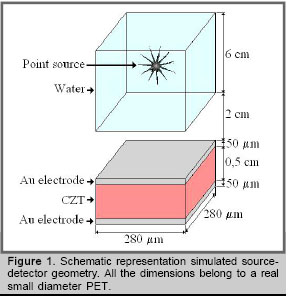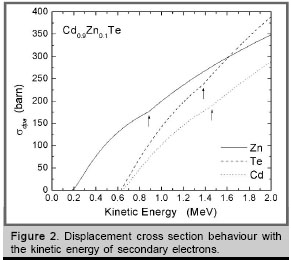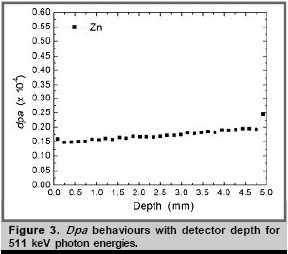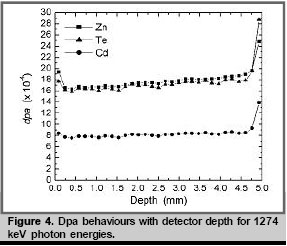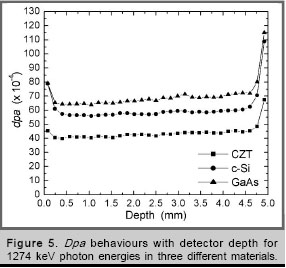Mi SciELO
Servicios Personalizados
Articulo
Indicadores
-
 Citado por SciELO
Citado por SciELO
Links relacionados
-
 Similares en
SciELO
Similares en
SciELO
Compartir
Nucleus
versión impresa ISSN 0864-084X
Nucleus n.45 Ciudad de La Habana ene.-jun. 2009
CIENCIAS NUCLEARES
Radiation damage study in CZT matrix detectors exposed to gamma rays
Estudio del daño radiacional en detectores matriciales de CZT expuestos a los rayos gamma
Antonio Leyva Fabelo1 , Ibrahin Piñera Hernández 1 , Olga Dona Lemus2 , Angelina Díaz García3, Carlos Manuel Cruz Inclán1 , Yamiel Abreu Alfonso1 , Luis Manuel Montaño Zétina4
1 Centro de Aplicaciones Tecnológicas y Desarrollo Nuclear (CEADEN)
Calle 30, No 502, entre 5 ta y 7 ma , Miramar, Playa, Ciudad de La Habana, Cuba
2 Centro Nacional de Seguridad Nuclear (CNSN)
3 Agencia de Energía Nuclear y Tecnologías de Avanzada (AENTA)
4 Centro de Investigación y Estudios Avanzados del IPN (CINVESTAV), México D.F.
aleyva@ceaden.edu.cu
RESUMEN
El daño radiacional en términos de desplazamientos atómicos en un típico detector de CZT empleado en aplicaciones de imagenología médica fue estudiado utilizando el método estadístico de Monte Carlo. Se tuvieron en cuenta todas las características estructurales y geométricas del detector, así como las diferentes energías de los fotones usualmente empleados en la aplicación. Considerando la aproximación clásica de Mott-McKinley-Feshbach
se calcularon las secciones eficaces de desplazamiento, así como el número de desplazamientos por átomo para cada especie atómica presente en el material y para cada energía considerada de los fotones. Estos
resultados se analizan y comparan entre sí y finalmente se establece la comparación entre el daño radiacional que tiene lugar en el detector de CZT con el que se manifiesta en un detector similar, pero fabricado con otros materiales semiconductores.
ABSTRACT
Radiation damage in terms of atomic displacements in a typical CZT detector used in medical imaging applications was studied using the Monte Carlo statistical method. All detector structural and geometric features as well as different energies of the photons usually used in the application were taken into account. Considering the Mott-McKinley-Feshbach classical approach, effective cross sections of the displacements were calculated, including the number of displacements per atom for each atomic species present in the material and each photon energy considered. These results are analyzed and compared. Finally, the radiation damage on CZT detector is compared
to that calculated in a similar detector manufactured with other semiconducting
materials.
Key words: Monte Carlo method, positron computed tomography, semiconductor detectors, mathematical models, atomic displacements, cross sections
Introduction
The study of the radiation detectors is a never- ending field in the experimental nuclear physics, determined not only by the constant growing applications spectrum, but for the permanent development of new materials with more advanced properties.
In the last decade the use of ![]() (CZT) in semiconducting radiation detectors fabrication has constituted an important technological step [1]. One of the fields where CZT detectors had found and extensive application is in medical imaging, as for example in Digital Mammography and Angiography or in Positron Emission Tomography (PET) [2, 3].
(CZT) in semiconducting radiation detectors fabrication has constituted an important technological step [1]. One of the fields where CZT detectors had found and extensive application is in medical imaging, as for example in Digital Mammography and Angiography or in Positron Emission Tomography (PET) [2, 3].
In this research we study some aspects of possible gamma radiation damage in CZT detectors working at room temperature as a consequence of its utilization in imaging applications, specifically in PET.
To reach this objective the mathematical simulation of the interaction processes between radiation and matter was used. The Monte Carlo statistical method and some physical approaches were employed.
Materials and methods
Figure 1 shows schematically the basic detecting geometry typically employed in researching small animal PET imaging system. One pixel (280 µm x 280 µm) of the CZT matrix detectors (5 mm thickness) with gold electrodes is irradiated by a point radiation source placed inside a water octahedron, which simulates a mammal body.
Two different energies for photon point sources were selected for simulation: 1274 keV - source energy used in the real experiment ( ![]() ) and 511 keV - photons energy due to positron annihilation.
) and 511 keV - photons energy due to positron annihilation.
For gamma rays transport simulation through the different experimental system details, the code Monte Carlo N-Particle version 2.6.B (MCNPX) [4] was used. This code system, based on the Monte Carlo statistical method, allows the study of spatial distribution of the radiation energy deposition in detectors and the calculation of secondary electron fluxes necessaries to evaluate the radiation damage. The transmitted electron spectrum was calculated using the *F4 tally.
All the geometric details of the system, as well as constituent materials particularities were taken into account in the simulation.
The data obtained from the simulation are normalized by number of particles emitted by the source, and all results have a relative error below 1%, which is guaranteed using ![]() incident photons in each simulation experiment.
incident photons in each simulation experiment.
The primary knock-on atom (PKA) displacement cross sections ![]() for each atomic species were calculated using the Mott-McKinley-Feshbach approach [5]:
for each atomic species were calculated using the Mott-McKinley-Feshbach approach [5]:

where Z is the atomic number of displaced atom, ![]() the hydrogen atom Bohr radius,
the hydrogen atom Bohr radius, ![]() the Rydberg energy,
the Rydberg energy, ![]() =v/c,
=v/c,![]() = Z/137,
= Z/137, ![]() the maximum energy transferred to the atom, m the electron mass and
the maximum energy transferred to the atom, m the electron mass and ![]() the threshold displacement energy.
the threshold displacement energy.
Results:
Obtained values of calculated secondary electrons maximum kinetic energy, using the photoelectric and Compton effects and pair-formation interaction equations (![]() ,
, ![]() and
and ![]() respectively), are presented in table 1. Using these data and applying the energy and momentum conservation laws it is possible to calculate the maximum transferred by the electron to the atom energy (
respectively), are presented in table 1. Using these data and applying the energy and momentum conservation laws it is possible to calculate the maximum transferred by the electron to the atom energy (![]() ) which values are also showed in table.
) which values are also showed in table.

The threshold displacement energies of the different atoms in the CZT do not appear reported explicitly in the literature. Taking into account that some authors consider that strictly speaking CZT is an alloy of binary
compounds CdTe and ZnTe, we will considerate in simulation the values of ![]() reported for these two compounds: 8.9 eV for the Cd, 7.35 eV for Zn and 7.25 eV for Te [6-8].
reported for these two compounds: 8.9 eV for the Cd, 7.35 eV for Zn and 7.25 eV for Te [6-8].
Introducing the ![]() values and the calculated
values and the calculated ![]() in (1) and taking in to account the Kinchin-Pease approximation for the damage function n(T) [9], the behaviours of effective displacement cross sections
in (1) and taking in to account the Kinchin-Pease approximation for the damage function n(T) [9], the behaviours of effective displacement cross sections ![]() with the secondary electrons kinetic energy were obtained and are presented in figure 2.
with the secondary electrons kinetic energy were obtained and are presented in figure 2.
This figure shows that probability of atomic displacements event is possible only for secondary electrons energies higher than 187 keV for Zn, 629 keV for Te and 645 keV for Cd atoms. It means that for the studied sources, atom displacements will be expected in all atomic species only for 1274 keV.
When the photon energy overcomes the 880 keV for Zn it begins to take place the multiple displacements phenomenon, which happens when the primary knockon atom (PKA) has enough energy to displace another atom by atom-atom collisions. The mentioned phenomenon is manifested by an obvious change in the curves behaviour. This threshold energy is 1380 keV for Te and 1450 keV for Cd, as it is observed in the figure 2, where the curve inflexion points are indicated by black arrows.
The dpa (displacements per atom) distributions with the detector depth were calculated starting from the secondary electrons flux values obtained by Monte Carlo simulation. Behaviours of in-depth dpa for the two used gamma energies are presented in figures 3 and 4.
In correspondence with its lower displacement cross section, the Cd atoms show smaller number of atomic displacement defects. The highest radiation damage in the detector is observed for the source of 1274 keV ( ![]() ). This damage in dpa terms is two orders higher than obtained for 511 keV ones.
). This damage in dpa terms is two orders higher than obtained for 511 keV ones.
In up showed behaviours in the vicinity of the interfaces CZT-electrode a radiation damage increment is observed. This phenomenon is a consequence of the backscattering in Au electrodes electrons. These secondary electrons previously leaved the CZT, scatter in electrodes atoms returning to the active material contributing to the new displacements formation.
The study of the radiation detectors is a neverending field in the experimental nuclear physics, determined not only by the constant growing applications spectrum, but for the permanent development of new materials with more advanced properties.
In the last decade the use of ![]() (CZT) in semiconducting radiation detectors fabrication has constituted an important technological step [1]. One of the fields where CZT detectors had found and extensive application is in medical imaging, as for example in Digital Mammography and Angiography or in Positron Emission Tomography (PET) [2, 3].
(CZT) in semiconducting radiation detectors fabrication has constituted an important technological step [1]. One of the fields where CZT detectors had found and extensive application is in medical imaging, as for example in Digital Mammography and Angiography or in Positron Emission Tomography (PET) [2, 3].
In this research we study some aspects of possible gamma radiation damage in CZT detectors working at room temperature as a consequence of its utilization in imaging applications, specifically in PET.
The calculated CZT dpa values become lower compared with similar calculations carried out with the same detector but based on other materials as crystalline silicon and gallium arsenide (see the figure 5). This indicates that CZT is more resistant material to the gamma radiation damage. Quantitatively this affirmation is evidenced in facts that the dpa number obtained for CZT is 28% smaller than for c-Si and 38% smaller than for GaAs.
In these results the defects recombination process have not beentaken into account. These mechanisms are amplified at high work detector temperature, then the real number of displacements will depressed even more.
The radiation damage study in CZT material as consequence of the photons irradiation is reported for the first time.
Conclusions
The radiation damage taking place in CZT detectors used in medical imaging applications was studied using Monte Carlo simulation and some classical approaches. The effective atomic displacement cross- sections and the number of dpa were calculated for all atomic species and two relevant photon energies. The highest radiation damage in CZT detector is observed for 1274 keV source, where the damage indpaterms is two orders stronger than for the other evaluated energy. Comparing with other detector materials, it was observed that in CZT the radiation damage is lower.
Acknowledgments
This research was supported by the Nuclear Energy and Advanced Technologies Agency of the Ministry of Science, Technology and Environment of Cuba through the project PRN/6-1/2.
References
[1] WAGENAAR DJ, PARNHAM K, SUNDAL B, et. al. Advantages of semiconductor CZT for medical imaging. Penetrating Radiation Systems and Applications VIII. Edited by Doty F. P., Barber HBr. and Roehrig H. Proceedings of the SPIE. vol. 6707. 2007. p.67070I.
[2] PISANO ED, YAFFE MJ, KUZMIAK CM. Digital Mammography, Lippincott Williams & Wilkins (LWW). 1st Edition. 2003.
[3] BAILEY DL, TOWNSEND DW, VALK PE, et. al. Positron Emission Tomography: Basic Sciences. First edition. London: Springer-Verlag, 2005.
[4] HENDRICKS JS, MCKINNEY GW, TRELLUE HR, et. al. MCNPX TM Version 2.6.B. Report. LA-UR-06-3248. Los Alamos National Laboratory, June 2006.
[5] MCKINLEY WA, FESHBACH H. The Coulomb Scattering of Relativistic Electrons by Nuclei. Phys Rev. 1948; 74(12): 1759-1763.
[6] BRYANT FJ, WEBSTER E. Threshold Energy for Atomic Displacement in Cadmium Telluride. Physica Status Solidi (b). 1967; 21(1): 315-321.
[7] BRYANT FJ, BAKER ATJ. Threshold energy for tellurium displacement in zinc telluride. J. Phys. C: Solid State Phys. 1972; 5(16): 2283-2288.
[8] MEESE JM. Zn displacement threshold in ZnTe. Appl. Phys. Lett. 1971; 19: 86-87.
[9] KINCHIN GH, PEASE RS. The displacement of atoms in solids by radiation. Rep. Prog. Phys. 1955; 18: 1-51.
Recibido: 07 de abril de 2009. Aceptado: 14 de mayo de 2009.













